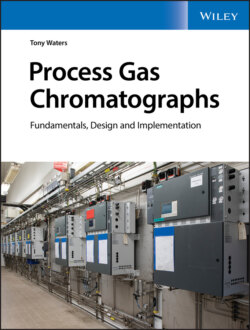Читать книгу Process Gas Chromatographs - Tony Waters - Страница 45
How peaks form Forming an equilibrium
ОглавлениеTo examine the interaction between a gas and a liquid, consider a small enclosed space that's internally divided into a gas space and a liquid space, as in Figure 2.3a. For explanatory purposes, the diagrams in Figure 2.3 show the gas space and liquid space as deep layers that would not work in practice. In a real column, the gas and liquid layers are very shallow, so the sample molecules can move quickly between them.
Figure 2.3 Forming an Equilibrium.
Let's assume that the gas space in Figure 2.3a is full of helium. This is equivalent to the carrier gas in a column; it's always there. The helium molecules contact the liquid phase, and a few of them dissolve in it. Since helium is always there, the amount dissolved soon becomes constant and can be ignored.
Now consider what happens when a small sample of (say) propane is injected into the helium gas in the enclosed space. To keep it simple, let's say there are only 32 propane molecules. The same logic applies to 32 trillion molecules, or to any other number of them. This is shown in Figure 2.3b.
The propane molecules move randomly in the gas phase and soon encounter the liquid surface where some of them dissolve. Initially, all the propane molecules are in the gas phase, so they frequently collide with the liquid surface and their rate of entry into the liquid is high. Then, as more of the molecules dissolve in the liquid, there are less of them in the gas phase, and their rate of entry declines.
The dissolved propane molecules move slowly in the liquid phase and eventually encounter the gas‐liquid surface, where some of them have enough energy to escape back into the gas phase. Initially, there are no propane molecules dissolved in the liquid phase, so none can escape; their rate of escape is zero. As more and more propane molecules dissolve, their rate of escape increases, as in Figure 2.3c.
With the rate of entry falling and the rate of escape rising, there must soon come a time when the two rates become equal. At this instant and beyond, every molecule that dissolves replaces one that escapes. The number of molecules in the gas phase is then constant, as is the number of molecules in the liquid phase. They will stay that way forever, as long as the operating conditions don't change.
This balancing act between two opposing and dependent processes is common in chemistry. Chemists call it a dynamic equilibrium.
There is nothing in our example that specifies the number of propane molecules in the gas phase and in the liquid phase once equilibrium has been achieved. That would depend on the solubility of propane in the selected liquid phase and would vary with different chemical compounds. To make it easy, though, let's assume that 50 % of the propane dissolves. Then, after reaching equilibrium, half of the molecules will be in the liquid phase, and the other half will be in the gas phase. This is the situation shown in Figure 2.3d.
Actually, it's reasonable to assume the propane solubility is 50 %, as that would generate a pretty good chromatogram. Yes, we can predict the position of peaks on the chromatogram from their solubility! You'll soon see how that works out.
In practice, it would not be difficult to set the propane solubility to exactly 50 %. We already know that the solubility of a given substance in a given liquid depends on temperature and pressure. So, to adjust the propane solubility simply change the temperature. It really is that simple. In fact, that's one way you can optimize the performance of a column.
